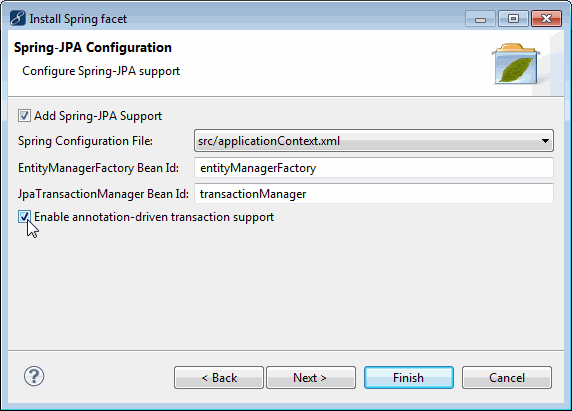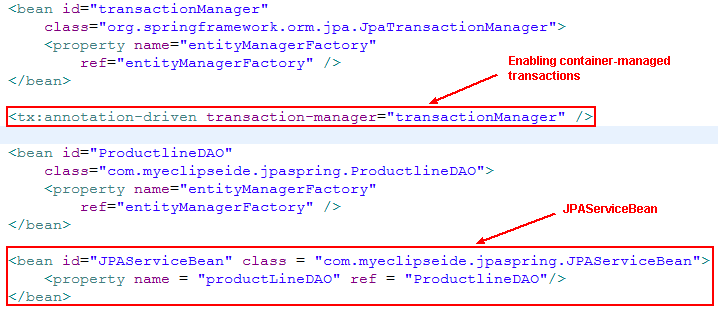本教程中介绍一些基于JPA/ spring的特性,重点介绍JPA-Spring集成以及如何利用这些功能。您将学习如何:
- 为JPA和Spring设置一个项目
- 逆向工程数据库表来生成实体
- 实现创建、检索、编辑和删除功能
- 启用容器管理的事务
在上文中,我们为大家介绍了如何用JPA和Spring Facets创建一个Java项目以及逆向工程,本文将继续介绍如何创建一个应用并启用容器管理的事务等。
MyEclipse技术交流群:742336981 欢迎一起进群讨论
3. 编写应用程序
现在MyEclipse已经生成了所有这些代码,您可以快速地专注于编写“业务逻辑”,或者更具体地说,“实际执行任务的代码”。
JPA教程介绍了每个实体和DAO类的功能,以及运行一个简单场景的主要方法的基本大纲,包括:
- 创建一个新实体并将其插入数据库
- 检索实体
- 更新实体
- 删除实体
类似地,在本教程中您将看到如何使用Spring获取和使用DAO以及管理事务。
这个演示的起点是RunJPA.java类,看看这个类中的main方法。
/* 1. Initialize the transactionManager and DAO */
ClassPathXmlApplicationContext ctx = new ClassPathXmlApplicationContext("/applicationContext.xml");
txManager = ((JpaTransactionManager) ctx.getBean("transactionManager"));
dao = ProductlineDAO.getFromApplicationContext(ctx);
/* 2. Create a reference to our ID */
String productlineID = "Men Shoes";
/* 3. Save a new productline to the DB */
saveProductline(productlineID);
/* 4. Load the productline from DB to make sure it worked */
loadProductline(productlineID);
/* 5. Update the productline in the DB and check it */
updateProductline(productlineID);
/* 6. Delete the productline from the DB */
deleteProductline(productlineID);
用蓝色标记的代码部分是Spring调用,您可以在其中从bean配置中检索已配置的bean。请注意,由于您正在手动管理事务,因此还需要从bean配置中检索' transactionManager '。
剩下的项目,#2 - #6,简单地调用每个“做某事”的方法。
3.1 保存实体
第一个有趣的方法是“saveProductline”,此方法的目的是创建一个新实体并将其存储在DB中。
/* 1. Create a new Productline instance */ Productline newProductline = new Productline(productlineID, "Shoes formen.", "<strong>MenShoes</strong>", null); /* 2. Store our new product line in the DB */ TransactionStatus status = txManager .getTransaction(new DefaultTransactionDefinition()); dao.save(newProductline); txManager.commit(status);
首先,用一些基本值创建新的Productline实例。其次使用transactionManager,事务在将实体保存到DB之前开始。在保存实体之后,事务被提交。
手动管理事务的目的是因为作为开发人员,您知道“保存”操作的范围。根据应用程序的编写方式,一些操作的作用域可能包含许多数据库修改,将所有这些都包装在一个事务中是很重要的,以防在工作进行到一半时失败。您肯定不希望让数据处于一种状态,其中一些是正确的,而另一些是过时的。
3.2 检索实体
下一个方法使用分配给实体的ID从DB中检索实体,并显示其值,这确认保存操作成功。
/* 1. Now retrieve the new product line, using the ID we created */
Productline loadedProductline = dao.findById(productlineID);
/* 2. Print out the product line information */
System.out.println("*NEW* Product Line [productLine="
+ loadedProductline.getProductline() + ", textDescription="
+ loadedProductline.getTextdescription() + "]");
注意在这段代码中,没有使用任何事务。原因是这段代码只执行读操作而不执行写操作,即使操作失败,DB中的任何数据都不会受到影响。因此,不需要使用事务来保护操作。
3.3 更新实体
现在下一段代码看起来可能更长,但这是因为它输出了新值,并确认在DB中更新了记录。
/* 1. Now retrieve the new product line, using the ID we created */
Productline loadedProductline = dao.findById(productlineID);
/*
* 2. Now let's change same value on the product line, and save the
* change
*/
loadedProductline.setTextdescription("Product line for men's shoes.");
TransactionStatus status = txManager
.getTransaction(new DefaultTransactionDefinition());
dao.update(loadedProductline);
txManager.commit(status);
/*
* 3. Now let's load the product line from the DB again, and make sure
* its text description changed
*/
Productline secondLoadedProductline = dao.findById(productlineID);
System.out.println("*REVISED* Product Line [" + "productLine="
+ secondLoadedProductline.getProductline()
+ ", textDescription="
+ secondLoadedProductline.getTextdescription() + "]");
请注意更新调用被封装在事务中,因为它必须向数据库写入一些内容,并且需要防止失败。
在上面的第3节中,产品线在更新后立即从数据库加载,并通过打印从数据库返回的值来确认更新。
3.4 删除实体
删除实体几乎等同于保存和更新实体,工作被封装在另一个事务中,然后DAO被告知去做这项工作。
/* 1. Now retrieve the new product line,
using the ID we created */
TransactionStatus status = txManager
.getTransaction(new DefaultTransactionDefinition());
Productline loadedProductline = dao.findById(productlineID);
/* 2. Now let's delete the product line from
the DB */
dao.delete(loadedProductline);
txManager.commit(status);
/*
* 3. To confirm the deletion, try and load it again and make sure it
* fails
*/
Productline deletedProductline = dao.findById(productlineID);
/*
* 4. We use a simple inline IF clause to test for null and print
* SUCCESSFUL/FAILED
*/
System.out.println("Productline deletion: "
+ (deletedProductline == null ? "SUCCESSFUL" : "FAILED"));
与上面的“updateProductline”实现类似,您会注意到一个事务用于封装“delete”调用,然后代码尝试从DB加载实体并确认操作应该失败。
注意:事务必须封装'findById '和'delete '方法调用的原因是因为JPA管理的对象必须是同一事务的一部分,要擦除已加载的对象,它必须处于加载它并尝试擦除它的同一个事务中。
3.5 运行程序
运行此命令的输出如下所示:

红色文本是可以忽略的默认日志消息(如果希望控制日志记录,您可以设置自定义log4j.properties文件),在日志警告下面,您可以看到来自TopLink (JPA实现库)的两条消息,以及来自实现的另外三条消息。
第一个消息打印出添加的新产品线信息,第二个消息更新产品线信息并打印新信息,最后一个消息从DB中删除产品线信息并打印确认消息。
4. 启用Spring容器管理的事务
除了用户管理的事务之外,Spring还通过@Transactional属性支持容器管理的事务。对于容器管理的事务支持,您必须在添加facet时启用它,这是您在本教程前面所做的。

启用此功能将向bean配置文件添加以下事务元素,您还应该添加一个JPAServiceBean,它用于使用容器管理的事务删除实体。请参阅下面的实现:

JPAServiceBean实现如下所示;注意'deleteProductLine '方法上的'@Transactional '注释和没有任何用户管理的事务语句。
public class JPAServiceBean
{ private IProductlineDAO dao; @Transactional public void deleteProductLine(String productlineID)
{ /* 1. Now retrieve the new product line, using the ID we created */Productline loadedProductline = dao.findById(productlineID);
/* 2. Now let's delete the product line from the DB */
dao.delete(loadedProductline);
/*
* 3. To confirm the deletion, try and load it again and make sure it * fails
*/
Productline deletedProductline = dao.findById(productlineID);
/*
* 4. We use a simple inline IF clause to test for null and print
* SUCCESSFUL/FAILED
*/
System.out.println("Productline deletion: " + (deletedProductline == null ? "SUCCESSFUL" : "FAILED"));}
public void setProductLineDAO(IProductlineDAO dao) { this.dao = dao; }
}
从应用程序上下文中获取JPAServiceBean实例,并按如下方式使用它:
JPAServiceBean bean = (JPAServiceBean) ctx.getBean("JPAServiceBean");
bean.deleteProductLine(productlineID);